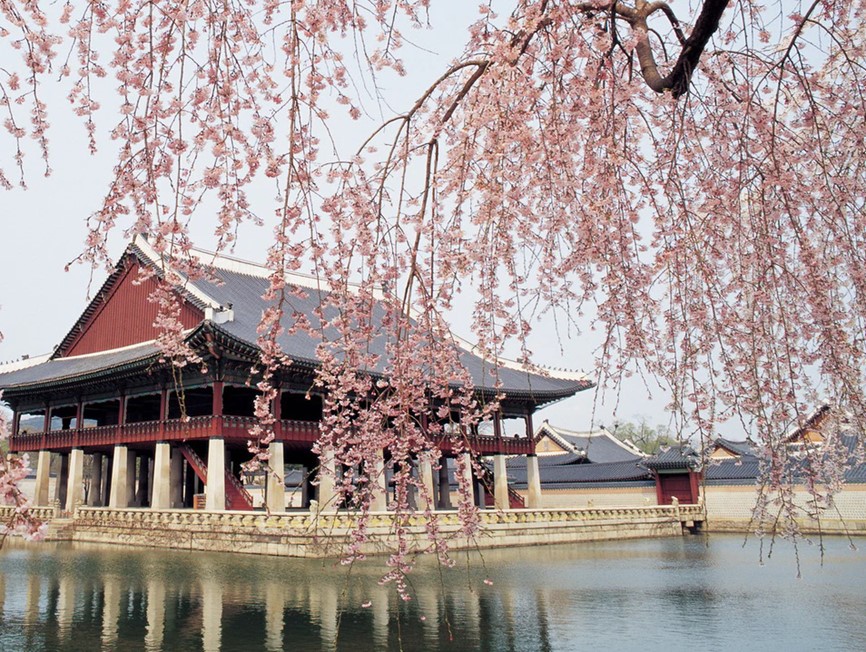
When learning about Korean culture, one of the holes many people fall into is learning about history. Many people refer to historical dramas when trying to learn about history. It is no doubt that there are many that enjoy historical dramas and believe it or not, the palaces you see in those dramas are real places that you can visit and learn more about! The last kingdom to reign in Korea was the Joseon Dynasty, which stood tall for 518 years from 1392 to 1910. During this period, the different rulers of the Joseon Dynasty constructed five palaces that still stand today — and they are all located in Seoul!
The first palace we’re going to talk about is the one that everyone knows about the most: Gyeongbokgung! Gyeongbokgung was built by King Taejo (Yi Seonggye) in 1395, but it was unfortunately burned down during the Japanese Invasion in 1592. However, with the help of Heungseon Daewongun, the palace was reconstructed during King Gojong’s reign in 1867 with a whopping 500 buildings! In the present, the most popular areas of the palaces are Hyangwonjeong Pond, Gyeonghoeru Pavilion, and the huge gates of Gwanghwamun. Many people seek to visit the palace every day and it is known for its unchanging beauty throughout the seasons.
Now we will move onto the East Palace, Donggwol: Changdeokgung and Changgyeonggung.
Changdeokgung was the second palace that was established after Gyeongbokgung and was built by King Taejong. Changdeokgung is known for its balance of architecture and landscaping, as it is built over a hill topography that is surrounded by nature. In other words, it is the epitome of harmonious architecture, nature, and rich culture!
Changgyeonggung, on the other hand was first built in 1418 with the name ‘Suganggung’ by King Sejong for the residence of his father , Taejong. Later, buildings were added by King Seongjong and renamed as ‘Changgyeonggung’. It was built for the purpose of creating supplementary living space for Jeonghui(Seongjong’s grandmother), Sohye(Seongjong’s mother), and ex-King Yejong’s wife Ansun. It is connected to Changdeokgung and together they are called “Donggwol(East Palace).” The palace was once destroyed in 1592 in the Japanese Invasion of Korea but was rebuilt in 1616. However, it was again nearly destroyed in the Great Fire which occurred in King Sunjo’s reign. The only structures which survived the fire and stand today are Myeongjeongjeon, Myeongjeongmun, and Honghwamun.
Lastly, we will cover the smaller of the five palaces: Deoksugung & Gyeonghuigung.
Deoksugung was built when King Seonjo, returned from Uiju to Hanyang in 1593 after Japanese invasion in 1592. However, after a series of political strife and affairs, Deoksugung was no longer considered a place for the King to reside or even engage in political affairs. However, Deoksugung eventually became an official palace again in 1897 after Gojong came back from taking refuge in Russian Legation for about a year in 1896 right after the Eulmi incident in 1895. But in 1904, a great fire had emerged, nearly consuming all of Deoksugung. Today it is known for its carved stone-wall road and prospering garden.
Last is Gyeonghuigung. The construction of Gyeonghuigung was completed in 1623 during the reign of Gwanghaegun. At first, it was called Gyeongdeokgung but it was changed to Gyeonghuigung in 1760 during King Yeongjo’s reign. In total were more than a hundred buildings in Gyeonghuigung, but when the reconstruction of Gyeongbokgung was complete most of the were moved there. As a result, the place was almost barren. But after its excavation, the Seoul Metropolitan Government restored Sungjeongjeon Hall and opened it to the public in 2002.
As we have explored, we can see that each palace has its own unique features and history! If you would like to learn more, I highly recommend visiting them when you can!
Written by: Romeo Celes Jr.
Originally from Waipahu, Hawaii, Current 5th year university student, Candidate for a Bachelor of Arts in Korean Language Flagship, Molecular & Cell Biology, and minor in Music at the University of Hawai’i at Mānoa, Exchange student at Korea University and Intern at VANK (Voluntary Agency Network of Korea)”